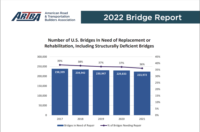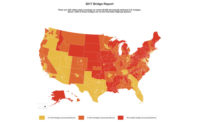States continue to chip away at the mammoth backlog of structurally deficient bridges, reducing the total of such spans by 4% last year, but the rebuilding job remains daunting, with 58,495 bridges still on the list, according to a new American Road & Transportation Builders Association report.
The ARTBA study, released on Feb. 18, draws on the Federal Highway Administration’s January update of its National Bridge Inventory data. It said about 9.5% of the nearly 610,000 U.S. bridges are structurally deficient.
ARTBA notes that the deficient-bridge roster isn’t static, observing that, as state agencies upgrade some spans, others deteriorate to subpar condition. In 2015, it says, about 7,200 bridges were improved, replaced or removed from the deficient category, but 4,625 bridges were added. Structurally deficient spans "may not be imminently unsafe" but do need repairs, the group adds.
Iowa had the largest number of deficient bridges, with 5,025, followed by Pennsylvania, with 4,783; Missouri, with 3,222; Nebraska, with 2,474; and Kansas, with 2,303.
Alison Premo Black, ARTBA chief economist, said in a statement that the new Fixing America’s Surface Transportation (FAST) Act, signed into law on Dec. 4, will help with bridge improvements. It authorizes $305 billion over five years, including $226 billion for highway programs, ARTBA calculates.
But Black said, “The funding made available won’t come close to making an accelerated national bridge repair program possible.”
The FAST Act’s overall highway obligation ceiling rises by about $2 billion, or 5%, this year, followed by modest 2% annual gains in the following four years.
State agencies have flexibility to fund bridge projects out of a variety of federal highway-aid categories.
Black said, “It’s going to take major new investments by all levels of government to move toward [to eliminate] the huge backlog of bridge work in the United States.”
States also have tapped federal Transportation Investment Generating Economic Recovery Act grants for bridges and other types of projects. TIGER grants aren’t included in the FAST Act, but Congress continues to fund the highly popular program. Its fiscal 2016 appropriation is $500 million.
Bridge funding is by no means totally a federal responsibility. ARTBA observes that non-federal funding accounted for an average of 48% of states’ highway and bridge capital outlays in the 2004-13 period. Washington state ranked first, with a 65% non-federal share; Rhode Island was last, at just 3%.
Pennsylvania, which is No. 2 on the deficient-bridge list, is taking an innovative approach to tackling its deteriorated bridges. The state Dept. of Transportation is in its second year of a three-year public-private partnership that aims to replace 558 bridges in the state. A team of Plenary Group, Walsh Construction Co., Granite Construction Co. and HDR Inc. will design, build, maintain and finance the bridges.




Post a comment to this article
Report Abusive Comment